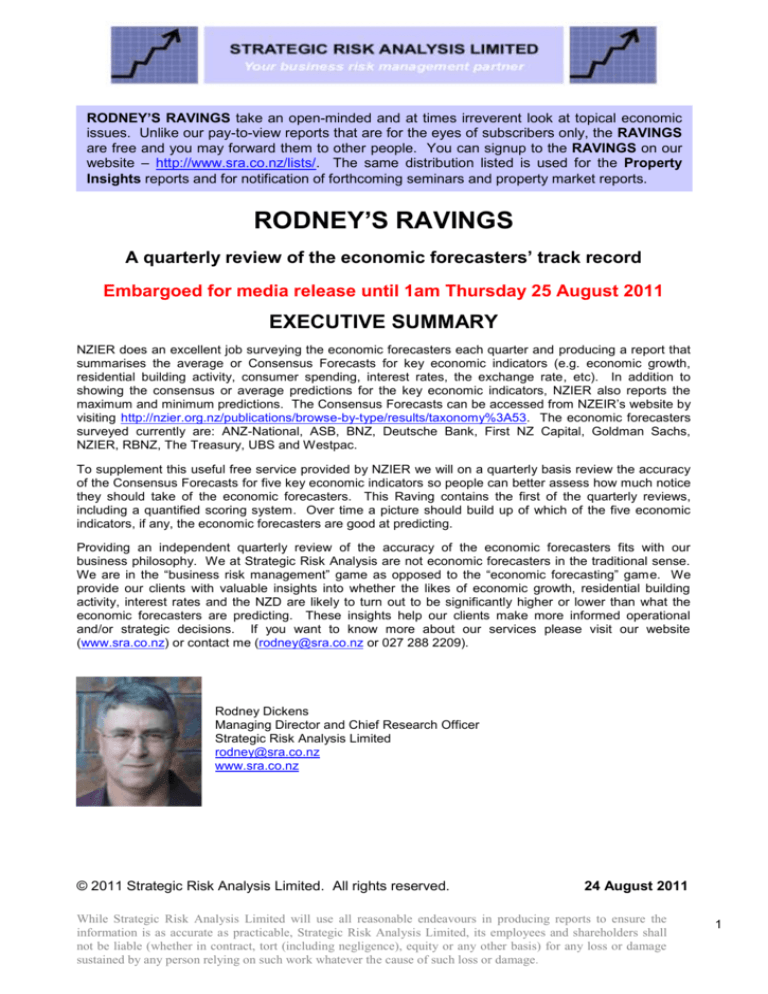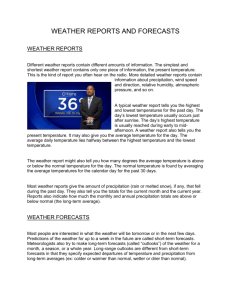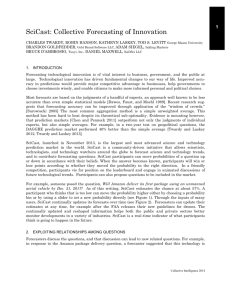
RODNEY’S RAVINGS take an open-minded and at times irreverent look at topical economic
issues. Unlike our pay-to-view reports that are for the eyes of subscribers only, the RAVINGS
are free and you may forward them to other people. You can signup to the RAVINGS on our
website – http://www.sra.co.nz/lists/. The same distribution listed is used for the Property
Insights reports and for notification of forthcoming seminars and property market reports.
RODNEY’S RAVINGS
A quarterly review of the economic forecasters’ track record
Embargoed for media release until 1am Thursday 25 August 2011
EXECUTIVE SUMMARY
NZIER does an excellent job surveying the economic forecasters each quarter and producing a report that
summarises the average or Consensus Forecasts for key economic indicators (e.g. economic growth,
residential building activity, consumer spending, interest rates, the exchange rate, etc). In addition to
showing the consensus or average predictions for the key economic indicators, NZIER also reports the
maximum and minimum predictions. The Consensus Forecasts can be accessed from NZEIR’s website by
visiting http://nzier.org.nz/publications/browse-by-type/results/taxonomy%3A53. The economic forecasters
surveyed currently are: ANZ-National, ASB, BNZ, Deutsche Bank, First NZ Capital, Goldman Sachs,
NZIER, RBNZ, The Treasury, UBS and Westpac.
To supplement this useful free service provided by NZIER we will on a quarterly basis review the accuracy
of the Consensus Forecasts for five key economic indicators so people can better assess how much notice
they should take of the economic forecasters. This Raving contains the first of the quarterly reviews,
including a quantified scoring system. Over time a picture should build up of which of the five economic
indicators, if any, the economic forecasters are good at predicting.
Providing an independent quarterly review of the accuracy of the economic forecasters fits with our
business philosophy. We at Strategic Risk Analysis are not economic forecasters in the traditional sense.
We are in the “business risk management” game as opposed to the “economic forecasting” game. We
provide our clients with valuable insights into whether the likes of economic growth, residential building
activity, interest rates and the NZD are likely to turn out to be significantly higher or lower than what the
economic forecasters are predicting. These insights help our clients make more informed operational
and/or strategic decisions. If you want to know more about our services please visit our website
(www.sra.co.nz) or contact me (rodney@sra.co.nz or 027 288 2209).
Rodney Dickens
Managing Director and Chief Research Officer
Strategic Risk Analysis Limited
rodney@sra.co.nz
www.sra.co.nz
© 2011 Strategic Risk Analysis Limited. All rights reserved.
24 August 2011
While Strategic Risk Analysis Limited will use all reasonable endeavours in producing reports to ensure the
information is as accurate as practicable, Strategic Risk Analysis Limited, its employees and shareholders shall
not be liable (whether in contract, tort (including negligence), equity or any other basis) for any loss or damage
sustained by any person relying on such work whatever the cause of such loss or damage.
1
Reviewing the Consensus Forecasts for economic growth
To properly review the accuracy of the consensus economic forecasts we need to look at what the
economic forecasters were predicting versus what happen over the forecast period. NZIER gets
predictions from the economic forecasters for the current and subsequent March years. We don’t believe
economic forecasters can provide much insight beyond the year ahead, so our review focuses on what the
economic forecasters were predicting roughly a year ago and what transpired.
To be useful from a
business risk management perspective the economic forecasters need to be able to give advance warnings
of upturn and downturns over the subsequent year or so.
GDP Growth & NZIER June 2010 Consensus Forecasts
Rolling annual average grow th based on quarterly GDP data (%)
6
Actual
Maximum
Average
Minimum
5
4
6
5
4
3
3
2
2
1
1
0
0
-1
-1
-2
-2
-3
Mar-98 Mar-00 Mar-02 Mar-04 Mar-06 Mar-08 Mar-10 Mar-12
-3
The black/thick line in the chart shows
rolling annual average GDP growth
based on the quarterly GDP data (i.e.
the percentage growth in the volume
of economic activity or GDP for the
last four quarters compared to the
same four quarters a year earlier).
Last month Stats NZ reported that
annual GDP growth for the 2010/11
March year was 1.5%.
When NZIER surveyed the economic
forecasters a little over a year ago in
June 2010 the average prediction for
GDP growth for the 2010/11 March
quarter was 3.2%.
The lowest
prediction by any of the economic
forecasters was 2.5% and the highest
prediction for GDP growth in the
2010/11 March year was 3.9%.
The economic forecasters get some marks for getting the direction right (i.e. that there would be positive
rather than negative economic growth), but they were on average significantly too positive about economic
growth (i.e. the outcome was slightly under half of what they were predicting and was outside the range of
what all the forecasters were predicting). The major earthquakes in Canterbury explain part of the deviation
and economic forecasters can’t be expected to predict earthquakes, but their overly optimistic predictions
were more because they were overly optimistic about underlying economic growth and especially about
residential building prospects, as discussed below. See page five for the quantified scoring.
Reviewing the Consensus Forecasts for residential building activity
Residential Building Activity & NZIER Consensus Forecasts *
8,000
Annual $m in 1995/96 prices
* Based on June 2010 survey of 10 economic forecasts
8,000
7,500
7,500
7,000
7,000
6,500
6,000
5,500
5,000
6,500
Actual
Maximum
Average
Minimum
6,000
5,500
5,000
4,500
4,500
Jun-98 Jun-00 Jun-02 Jun-04 Jun-06 Jun-08 Jun-10 Jun-12
The black/thick line in the chart
shows the rolling annual level of
residential building activity, which
includes
new
buildings
and
alterations and additions to old
buildings. It is measured in dollar
terms, but the level of activity is
measured in constant price terms (i.e.
based on prices in the 1995/96 March
year), which means the chart
effectively shows the volume of
residential building activity.
On average the economic forecasters
were in June 2010 predicting $5.8b of
residential building activity in the
2010/11 March year (in 1995/96 price
terms) when the outcome was 14%
lower at $5b. The most optimistic of
While Strategic Risk Analysis Limited will use all reasonable endeavours in producing reports to ensure the
information is as accurate as practicable, Strategic Risk Analysis Limited, its employees and shareholders shall
not be liable (whether in contract, tort (including negligence), equity or any other basis) for any loss or damage
sustained by any person relying on such work whatever the cause of such loss or damage.
2
the forecasters was predicting $6.2b and the most pessimistic was predicting $5.3b. In this instance the
economic forecasters didn’t even get the direction right so none of them were much use in providing useful
insights for firms and individuals impacted by cycles in residential building (see page 5 for the quantified
scoring). The underperformance of residential building activity compared to what the economic forecasters
were predicting had little to do with the negative impact of the Canterbury earthquakes, with it being mainly
due to the economic forecasters not understanding what was going on in the housing market and especially
not realising the major negative impact of the property tax changes announced in the May 2010 Budget.
The major relevance of the property tax changes to residential building activity and overall economic growth
went almost unnoticed by the economic forecasters.
Being overly optimistic about the outlook for residential building played a significant part in the economic
forecasters being too optimistic about economic growth prospects. The pivotal role housing market activity
and house prices play in economic cycles was covered in Chapter Two of the How the Economy Works
booklet (see http://sra.co.nz/pdf/PivotalHousing.pdf). If the economic forecasters can’t get the direction of
residential building activity right they have little chance of providing advance warnings of economic upturns
and downturns or of predicting the outlook for interest rates (see below). By contrast, we provided clients
with advanced warnings of the downturn in housing market activity in 2010 and we correctly warned that
economic growth would be significantly weaker than predicted by the RBNZ and that interest rates would
not increase anywhere near as much as the economic forecasters were predicting, although economic
growth turned out even weaker than we warned (see http://sra.co.nz/pdf/EconomicTrackRecord.pdf for a
review of our forecasting track record in 2010).
Reviewing the Consensus Forecasts for interest rates
NZIER surveys the economic forecasters’ predictions for the 90-day bank bill yield and the 10-year
government bond yield. The 90-day bank bill yield is the benchmark short-term wholesale interest rate that
both reflects the market’s assessment of the near-term outlook for the OCR and plays a major part in
driving the short-term interest rates faced by borrowers (e.g. the floating and short-term fixed mortgage
interest rates and the base business lending rates set by banks). The 90-day bank bill yield is the only
interest rate the RBNZ forecasts, with these predictions being proxies for OCR forecasts. The 10-year
bond yield is of more relevance as a benchmark of the longer interest rates available to investors and as
the main measure of the “risk free” interest rate used in assessing the value of shares and the like.
In general the outlook for the 90-day bank bill yield is of relevance to more people, while it has implications
for the outlook for the 10-year bond yield and for medium-term and longer-term interest rates more
generally. From one perspective, the market’s expectation of the OCR over the next 10 years determines
the current 10-year bond yield. From another perspective, the 10-year bond yield changes in response to
changes in the market’s expectation about the OCR and to changes in international and especially US bond
yields. But the two perspectives should add up to the same outcome for the 10-year bond yield.
90-Day Bank Bill Yield & NZIER Consensus Forecasts *
Annual average %
* June 2010 consensus forecasts
11
10
11
10
Actual
Maximum
Average
Minimum
9
8
9
8
7
7
6
6
5
5
4
4
3
3
2
Jan-92
2
Jan-95
Jan-98
Jan-01
Jan-04
Jan-07
Jan-10
The black/thick line in the chart shows
the rolling annual average of the 90day bank bill yield. The 90-day bank
bill yield has largely drifted sideways
over the last year at just under 3%.
The average prediction of the
economic forecasters survey by
NZIER in June 2010 was that it would
average 3.7% in the 2010/11 March
year and 5.3% in the 2011/12 March
year (see the blue line). If I interpolate
between these two predictions it
implies that the forecasters were on
average predicting that the rolling
annual average of the 90-day bank bill
would be around 4.4% now compared
to an outcome of 2.9%. The minimum
and maximum forecasts lines in the
chart show that all of the forecasters
While Strategic Risk Analysis Limited will use all reasonable endeavours in producing reports to ensure the
information is as accurate as practicable, Strategic Risk Analysis Limited, its employees and shareholders shall
not be liable (whether in contract, tort (including negligence), equity or any other basis) for any loss or damage
sustained by any person relying on such work whatever the cause of such loss or damage.
3
surveyed by NZIER in June 2010 were predicting significant increases in the 90-day bank bill yield over the
subsequent two years. In terms of their 90-day bank bill yield predictions the economic forecasters should
get low marks in this instance (see page 5 for the quantified scoring).
The 90-day bank bill yield predictions are roughly consistent with the predictions that economic growth
would be robust, which meant an element of internal consistency between the Consensus Forecasts for
economic growth and the 90-day bank bill yield. But if the 90-day bank bill yield increased as much as the
economic forecasters were predicting it would result in sizeable increases in the cheapest available
mortgage interest rates (i.e. the floating and short-term fixed rates), which would in turn result in falling
rather than surging residential building activity. Every past cyclical increase in mortgage interest rates has
resulted in a cyclical fall in residential building activity 2-3 quarters later.
What we learn from reviewing the Consensus Forecasts is that the economic forecasters in at least this
instance produced forecasts that are internally inconsistent, which is supposed to be a no-no for economic
forecasters. Dr Rod Deane, best known now for his role at Telecom, was the Chief Economist at the RBNZ
when I was recruited in 1980. He was the founder of mathematical, economic forecasting models in New
Zealand. He taught us novice forecasters that a key role of an economic forecasting model is to ensure
internal consistency of the forecasts. Unfortunately, the modern economic forecasters seem to have
forgotten this cardinal rule, which will greatly inhibit their ability to provide useful insights.
The black/thick line in the adjacent
chart shows the rolling annual average
Annual average %
of the 10-year government bond yield.
9
9
* June 2010 consensus forecasts
The 10-year bond yield has fallen
8.5
8.5
significantly over the last year, which
Actual
partly reflects the market adjusting
8
8
Maximum
downwards expectations for the OCR
Average
and partly reflects falling US bond
7.5
7.5
Minimum
yields. Being overly hawkish about
7
7
the outlook for the 90-day bank bill
yield will have played a significant part
6.5
6.5
in the economic forecasters on
6
6
average predicting a rising 10-year
bond yield in June 2010, just in time
5.5
5.5
for it to fall. Again, the Consensus
5
5
Forecasts didn’t get the direct right,
Jan-94
Jan-97
Jan-00
Jan-03
Jan-06
Jan-09
Jan-12
although one of the forecasters
surveyed in June 2010 got very close
to accurately predicting the annual average level of the 10-year bond yield in the 2010/11 March year (see
the red line following the black line up to March 2011, but thereafter deviating).
10-Year Bond Yield & NZIER Consensus Forecasts*
Reviewing the Consensus Forecasts for the exchange rate
NZIER survey what the economic forecasters are predicting for the trade-weighted value of the NZD (i.e.
the trade-weighted index or TWI). This measure of the exchange rate is relevant to economists and the
RBNZ in assessing the impact of the NZD on the
NZD Cross Rates
economy. The NZD TWI is based on the value of
1
Yen is the right hand scale, all others are the left hand scale
100
the NZD against the USD (0.3023), the Euro
AUD
0.9
90
(0.2797), the AUD (0.2126), the Yen (0.1425) and
the Pound Sterling (0.0629). It is 50:50 weighted
0.8
80
according to:
0.7
70
Yen
0.6
0.5
60
50
USD
Euro
0.4
Pound
0.3
0.2
Jan-90
40
30
20
Jan-93
Jan-96
Jan-99
Jan-02
Jan-05
Jan-08
Jan-11
Each currency area's share of NZ's
merchandise trade (exports plus imports),
normalised to total 100 percent; and
Each currency area's share of the combined
nominal GDP of the five currency areas.
The weights (in parenthesis above), are updated
annually, most recently on 16 December 2010.
While Strategic Risk Analysis Limited will use all reasonable endeavours in producing reports to ensure the
information is as accurate as practicable, Strategic Risk Analysis Limited, its employees and shareholders shall
not be liable (whether in contract, tort (including negligence), equity or any other basis) for any loss or damage
sustained by any person relying on such work whatever the cause of such loss or damage.
4
In client reports the economic forecasters focus more on the cross rates that are relevant to exporters and
importers (e.g. NZD/USD, NZD/AUD etc), but reflecting NZIER’s focus on the economy it surveys the TWI
forecasts rather than NZD/USD forecasts.
The black/thick line in the adjacent
chart shows the rolling annual average
Annual average
of the NZD TWI. Up until around
75
75
March this year the TWI increased
Actual
roughly in line with the June 2010
Maximum
70
70
Consensus Forecasts, although it has
Average
since headed a bit higher than the
Minimum
65
65
economic
forecasters
were
on
average predicting in June 2010. On
60
60
this front they appear to deserve some
55
55
praise.
But having reviewed the
Consensus Forecasts for the TWI over
50
50
a number of years I can reveal that the
coincidence of the predictions with the
45
45
outcome was more an accident than
Jan-92 Jan-95 Jan-98 Jan-01 Jan-04 Jan-07 Jan-10
good judgement.
The Consensus
Forecasts generally predict that the
TWI will revert to around the historical average level, so in the rare event this happens the Consensus
Forecasts will be reasonably accurate. But it is more often the case that the TWI ends up spiking
significantly above or below the average level. The other observation about the TWI predictions is that the
economic forecasters have almost covered all bases (i.e. there is a wide spread between the maximum and
minimum predictions). This means that one of them has a reasonable chance of getting it right, although
you are unlikely to know which one in advance, while it is important to note that the forecaster predicting the
highest/lowest TWI in one March year may not be the same forecaster who is predicting the highest/lowest
TWI in the subsequent March year.
NZ Dollar TWI & NZIER June 2010 Consensus Forecasts
Scoring the accuracy of the Consensus Forecasts
We have adopted a 0-10 scoring system for quantifying the accuracy/usefulness of the Consensus
Forecasts. The score is 10 if the Consensus Forecasts were close to the mark, meaning they would have
been of great value to end-users (i.e. to business managers and individuals impacted by the economic
indicator in question). A score of zero is awarded if the Consensus Forecasts were so far from the mark
that they would have been of little or any use to end-users. Scores between zero and 10 are awarded
based on how far the outcomes were from the Consensus Forecasts. The next page presents the
forecasting scoring table we use to derive the scores for each of the five key economic indicators we are
focusing on. The associated text on the next page explains how we use the scoring table.
Forecasting Scores Out of Ten
June 2010 Consensus Forecasts
10
9
8
7
6
5
4
3
2
1
0
Economic
Grow th
Residential
Building
90-Day Bank 10-Year Bond
Bill Yield
Yield
NZD TWI
The scores for the June 2010
Consensus Forecasts are shown in
the adjacent chart. Based on the
forecasting scoring table we are using,
the Consensus Forecasts score 4/10
for economic growth, residential
building activity and the 90-day bank
bill yield (i.e. well below pass GO and
pick up $200 scores). The Consensus
Forecasts score 5/10 for the 10-year
government bond yield and a
respectable 8/10 for the NZD TWI, but
this outcome might be more by chance
than by good judgement, as discussed
above.
Based on the June 2010
Consensus Forecasts the forecasters
would be kept back a year.
While Strategic Risk Analysis Limited will use all reasonable endeavours in producing reports to ensure the
information is as accurate as practicable, Strategic Risk Analysis Limited, its employees and shareholders shall
not be liable (whether in contract, tort (including negligence), equity or any other basis) for any loss or damage
sustained by any person relying on such work whatever the cause of such loss or damage.
5
Some general observations about the forecasting track record
In general the Consensus Forecasts predict that most economic indicators will revert to around average or
trend levels. In the 2010 June survey NZIER found that the economic forecasters were on average
predicting just over 3% GDP growth for both the 2010/11 and 2012/13 March years. When it comes to
predicting economic growth the forecasters have a strong predisposition to predict around 3% growth,
which reflects a somewhat optimistic assessment of the historical average rate of annual GDP growth.
If you look at the Consensus Forecasts for residential building activity, the 90-day bank bill yield and the 10year bond yield (the respective blue lines in the charts above) you will find that they also tend to “mean
revert”. This means that on average over the long-term the economic forecasters will be reasonably close
to the mark, but in any one year economic growth, residential building activity, interest rates and the
exchange rate are more likely to end up some distance from the historical averages. This implies that the
economic forecasters are unlikely to provide many useful insights for business risk management purposes.
However, this is jumping the gun based on my knowledge of the past track record of the economic
forecasters. If my observations are correct (i.e. the economic forecasters often get the direction of a
number of key economic indicators wrong and have a tendency to cling to historical averages) it will be
revealed as we review the track record of the economic forecasters in the future.
How the accuracy of the Consensus Forecasts are scored
We are using a 0-10 scoring system for quantifying the accuracy/usefulness of the Consensus Forecasts.
The score is 10 if the deviation between the outcome and the Consensus Forecasts is equal to or less than
plus or minus 0.25% for GDP growth, +/- $0.25b for residential building activity, +/- 0.25% for the 90-day
bank bill yield, +/- 0.25% for the 10-year government bond yield and +/- 1.5 for the NZD TWI. If the
outcomes deviate from the Consensus Forecasts by more than the following amounts we assess that the
forecasts are of little or no help and a score of zero awarded: +/- 3% deviation for economic growth; +/$1.25b for residential building activity; +/- 2.5% for the 90-day bank bill yield; +/- 1.5% for the 10-year bond
yield; and +/- 10 for the NZD TWI. The numbers used for each of the five economic indictors reflect how
much each indicator has varied in the past, which has implications for how close the Consensus Forecasts
need to be to the outcomes to be of value.
The table below shows how the score falls from 10 to 0 based on increasing deviations between the
outcomes and the Consensus Forecasts (e.g. if the difference between the outcome for economic growth
and the Consensus Forecast is greater than +/- 0.25% but less than +/- 0.525% the score is 9; if the
deviation is greater than +/- 0.525% but less than +/- 0.8% the score is 8, etc).
Consensus Forecasting Track Record Scoring Table
Deviation between predictions and outcomes
Score
Economic
Growth
Residential
Building
10
9
8
7
6
5
4
3
2
1
0
+/- 0.25%
+/- 0.525%
+/- 0.8%
+/- 1.075%
+/- 1.35%
+/- 1.625%
+/- 1.9%
+/- 2.175%
+/- 2.45%
+/- 2.725%
+/- 3%+
+/- $0.25b
+/- $0.35b
+/- $0.45b
+/- $0.55b
+/- $0.65b
+/- $0.75b
+/- $0.85b
+/- $0.95b
+/- $1.05b
+/- $1.15b
+/- $1.25b
90-Day Bank Bill
Yield
10-Year Gov't
Bond Yield
NZD TWI
+/- 0.25%
+/- 0.475%
+/- 0.7%
+/- 0.925%
+/- 1.15%
+/- 1.375%
+/- 1.6%
+/- 1.825%
+/- 2.05%
+/- 2.275%
+/- 2.5%+
+/- 0.25%
+/- 0.375%
+/- 0.5%
+/- 0.625%
+/- 0.75%
+/- 0.875%
+/- 1.0%
+/- 1.125%
+/- 1.25%
+/- 1.375%
+/- 1.5%+
+/- 1.5
+/- 2.35
+/- 3.2
+/- 4.05
+/- 4.9
+/- 5.75
+/- 6.6
+/- 7.45
+/- 8.3
+/- 9.15
+/- 10
While Strategic Risk Analysis Limited will use all reasonable endeavours in producing reports to ensure the
information is as accurate as practicable, Strategic Risk Analysis Limited, its employees and shareholders shall
not be liable (whether in contract, tort (including negligence), equity or any other basis) for any loss or damage
sustained by any person relying on such work whatever the cause of such loss or damage.
6









